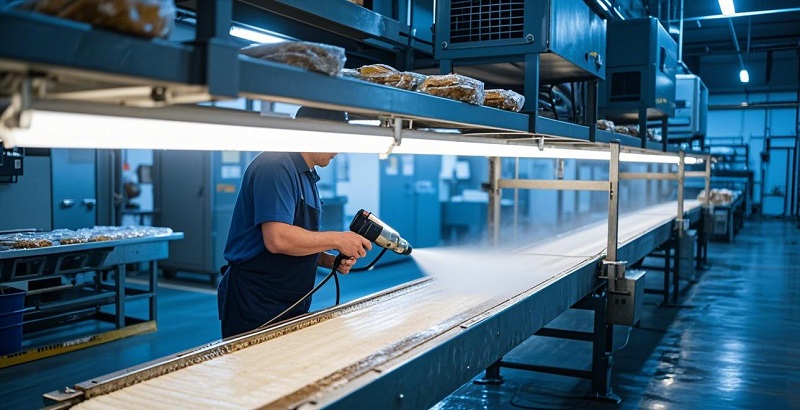Tel: +86-532-84673097
Mobile & Whatsapp & Wechat:+86-13589340409
Mobile & Whatsapp & Wechat:+86-13589340409
Conveyor belts are the backbone of industries like manufacturing, mining, food processing, agriculture, and logistics, enabling the seamless movement of materials. However, to maintain their efficiency, safety, and compliance with industry standards, regular cleaning is essential. A dirty conveyor belt can lead to product contamination, operational inefficiencies, safety hazards, and costly downtime.
In this blog, Rentone, a trusted manufacturer of high-quality conveyor belts a, shares professional tips and best practices to help you maintain your system in top condition.
A dirty conveyor belt can cause:
Material carryback, leading to blockages or product contamination
Premature wear and tear on belts and components
Reduced efficiency in product handling
Increased safety risks for operators
Regular cleaning prevents these issues, reduces maintenance costs, and ensures compliance with health and safety standards, especially in industries with strict hygiene requirements.
Conveyor belts vary in material, design, and application, each requiring specific cleaning approaches. Below is a breakdown of common types and their cleaning considerations:
| Belt Type | Common Applications | Cleaning Considerations |
| Fabric Conveyor Belts | General manufacturing, logistics | Dry cleaning (brushing, vacuuming) for dust and debris; wet cleaning for deeper sanitation. |
| Steel Cord Conveyor Belts | Mining, heavy-duty material handling | Robust methods like scraping or high-pressure air for stubborn materials. |
| Solid Woven Conveyor Belts | Food processing, pharmaceuticals | Wet cleaning with FDA-approved detergents to ensure hygiene; smooth surfaces aid cleaning. |
| Special Conveyor Belts | Harsh environments (heat, oil, chemicals) | Tailored methods based on resistance properties; consult manufacturer guidelines. |
| Tubular Conveyor Belts | Enclosed systems, long-distance transport | Specialized tools for internal cleaning to prevent material buildup. |
Rentone Belt's diverse product range is engineered with maintenance in mind. For example, our Solid Woven Conveyor Belts feature smooth surfaces that resist material adhesion, simplifying cleaning, while our Tubular Conveyor Belts minimize internal contamination, reducing cleaning frequency.
Effective cleaning depends on the belt type, industry requirements, and environmental conditions. The two primary methods are dry cleaning and wet cleaning, with advanced technologies offering additional options.
1. Dry Cleaning
Dry cleaning is ideal for environments where water could damage the product or belt, such as in certain manufacturing or dry processing settings. Methods include:
Brushing: Soft or stiff brushes remove loose debris and dust. Microfiber brushes are recommended for delicate surfaces.
Vacuuming: Effective for small particles and dust buildup, ensuring a clean surface without water.
Scraping: Scrapers remove stubborn materials, but care must be taken to avoid damaging the belt. Tungsten carbide-tipped scrapers offer durability and effectiveness.
2. Wet Cleaning
Wet cleaning is essential for high-hygiene industries like food processing, where thorough disinfection is required to prevent contamination. The process typically involves:
Pre-rinsing: Use water to remove large debris and loose particles.
Applying Cleaning Agents: Select detergents or sanitizers compatible with the belt material and industry standards (e.g., FDA-approved for food-grade belts). Consult your detergent supplier to ensure compatibility.
Rinsing: Thoroughly rinse off all cleaning agents to prevent residue buildup.
Drying: Ensure the belt is completely dry using air blowers or natural drying to prevent mold or bacterial growth.

Advanced Cleaning Technologies
For industries requiring stringent hygiene or efficiency, advanced cleaning solutions can enhance results:
Automated Cleaning Systems: These systems clean belts without manual intervention, ensuring consistency and reducing labor costs. They are particularly useful in large-scale operations.
Steam Cleaning: High-temperature dry steam, exceeding 212°F, disinfects belts effectively with minimal effluent, making it ideal for food-grade applications and facilities without drains.
To maximize the effectiveness of your cleaning efforts, follow these best practices:
Establish a Regular Cleaning Schedule: Consistent cleaning prevents material buildup, reducing the risk of belt damage and ensuring operational efficiency. The frequency depends on the industry and material conveyed.
Use Appropriate Tools: Select brushes, scrapers, or cleaning agents suited to your belt type. For example, smooth polyethylene belts are easier to clean than steel-wire mesh, which may require specialized tools.
Prioritize Safety: Always shut down the conveyor system before cleaning to prevent accidents. Use personal protective equipment (PPE) like gloves and safety glasses, and ensure workers are trained on safety protocols (IBT).
Train Your Team: Proper training ensures cleaning is performed correctly, reducing the risk of damage to the belt or injury to workers.
Inspect Regularly: Conduct routine inspections to identify wear, damage, or excessive buildup. Tools like carryback gauges can measure cleaning effectiveness by collecting residual material.
Avoid these common pitfalls to ensure effective cleaning:
Using Incompatible Cleaning Agents: Harsh chemicals can damage belts. Always verify compatibility with the belt material and industry standards.
Neglecting to Dry the Belt: Residual moisture can lead to mold, corrosion, or bacterial growth, particularly in food-grade applications.
Overlooking Hard-to-Reach Areas: Clean rollers, pulleys, and other components, not just the belt surface, to prevent cross-contamination.
Ignoring Manufacturer Guidelines: Follow specific cleaning instructions provided by the manufacturer, as different belts have unique requirements.
Reduced Downtime: Preventive maintenance minimizes unexpected breakdowns, keeping operations running smoothly.
Lower Replacement Costs: Well-maintained belts last longer, reducing the need for frequent replacements.
Improved Efficiency: Clean belts operate with less friction, reducing energy consumption and enhancing productivity.
Cleaning conveyor belts is a critical practice for maintaining efficiency, safety, and compliance in industrial operations. By understanding the specific needs of different belt types, employing appropriate cleaning methods, and adhering to best practices, you can ensure your conveyor systems perform at their best. Rentone Belt, a trusted conveyor belt manufacturer in China, offers a wide range of high-quality conveyor belts designed for durability and ease of maintenance. Whether you need Fabric, Steel Cord, or Tubular Conveyor Belts, our products support your operations with reliability and efficiency.
Contact Rentone Belt today at info@rentone-belt.com or +86-532-84673097 to learn how our conveyor belts can enhance your operations and simplify maintenance.